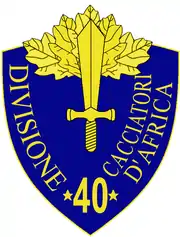40th Infantry Division Cacciatori d'Africa
The 40th Infantry Division "Cacciatori d’Africa" (Hunters of Africa) was an infantry division of the Italian Army (Regio Esercito Italiano) during World War II. It was formed 27 July 1940 and dissolved 15 May 1941. The divisions Cacciatori d’Africa and 65 Infantry Division Granatieri di Savoia were outside of the normal chain of command, being subordinated directly to Prince Amedeo, Duke of Aosta.,[1] together with other colonial troops in Italian East Africa.
| 40th Infantry Division Cacciatori d’Africa | |
|---|---|
 40th Infantry Division Cacciatori d'Africa Insignia | |
| Active | 27 July 1940 – 15 May 1941 |
| Country | Italy |
| Branch | Italian Army |
| Type | Infantry |
| Size | Division |
| Nickname(s) | Cacciatori d’Africa |
| Engagements | World War II East African Campaign |
| Commanders | |
| Notable commanders | General Giovanni Varda |
Actions of main divisional body
After East African Campaign (World War II) started 10 June 1940, the supply and reinforcements for Italian East Africa were sporadic to non-existent, resulting in Cacciatori d’Africa division being severely understrength. For example, the infantry "regiments" contained only two battalions, and artillery "regiment" had only one group (battalion) of Cannone da 65/17 modello 13 light guns.[2]
From the formation 27 July 1940 until end of December, 1940, the Cacciatori d’Africa were limited to defending the fortified walls of Addis Ababa. From January 1941, as the ranks of division grew due to recruitment, the division started to take additional positions outside the walls. After the disastrous Battle of Keren, 23 March 1941, the Cacciatori d’Africa transferred its 210th Bisagno Infantry Regiment and 65-mm artillery to 65th Infantry Division Granatieri di Savoia. On 31 March 1941, the 211th Pescara Infantry Regiment was placed under direct command of Italian East Africa High Command, and sent to Amba Alagi mountain. On the same day, the divisional headquarters had moved to Dessie, and the remaining units of Cacciatori d’Africa were distributed to various other units tasked with the defence of the line Danakil Depression-Amba Alagi-Addis Ababa.
After Addis Ababa 6 April 1941 fell to British forces led by Alan Cunningham, the Cacciatori d’Africa erected a defensive positions at Kombolcha airbase and at Bati. These defences came under attack from 17 April 1941, by 1st South African Brigade and Campbell's Scouts. By 19 April 1941, the Italian defensive lines were in disarray due to air-strikes, allowing multiple sections to be overrun by British armoured forces 19–21 April 1941. Increased shelling by British artillery forced a full abandonment of the 1st line of defences near Bati 22 April 1941. 25 April 1941 Kombolcha airbase fell, and Dessie was overrun 26 April 1941, forcing the Cacciatori d’Africa divisional command to transfer to Bati and then immediately to Tendaho in the desert to the east. By 6 May 1941, the survivors of Cacciatori d’Africa had retreated to Danakil to make a last stand. Pressure from the Ethiopian Patriots have mounted up in the period 7–15 May 1941, forcing remaining Italian forces to flee to Assab port, where they remained holed up until 10 June 1941. During 10–11 June 1941, all survivors of Cacciatori d'Africa division were either killed or taken prisoner by Indian forces in "Operation Chronometer".
Actions of 210th Infantry Regiment
The Bisagno regiment was sent to Āwash 21 March 1941. It was then split on two battalions 1 April 1941, sent separately at Dessie and to south of Addis Ababa. The 1st battalion sent to Dessie was ambushed by Ethiopian Patriots and annihilated 7 April 1941. 2nd battalion have reached a destination of Sidama Zone and came under command of 25th Colonial Division. It continued to fight until been destroyed 22 May 1941, in the area of Sodo.
Actions of 211th Infantry Regiment
During fall of Dessie 26 April 1941, the Pescara regiment have stayed on positions at Kalaga, Ethiopia. Participating on the peripheral roles in the Battle of Amba Alagi 4–19 May 1941, it surrendered together with other Italian units 19 May 1941.
Order of battle
July 1940
17 April 1941
- 3. Blackshirt CCNN Battalion
- 11. Blackshirt CCNN Battalion
- 12. Blackshirt CCNN Battalion
- 18. Colonial Engineer Battalion
- 32. Colonial Battalion Danakil
- 40. Colonial Battalion of Gojjam
- 52. Colonial Battalion of Gojjam
- 11. Colonial dismounted squad
- Assab garrison Battalion
- Regia Marina Marines Battalion
- 2 batteries of Canon de 105 mle 1913 Schneider
- 3 batteries of 8 cm FK M. 5
- 3 batteries of 76/40 Mod 1916 RM
- 2 batteries of Skoda 75 mm Model 15
- 2 batteries of Cannone da 75/46 C.A. modello 34
6 May 1941
- 4 Camel Companies
- 2. Colonial Coastal Battalion
- Regia Aeronautica motorized battalion
- Regia Marina Marines Company
- Artillery battery
- Auxiliaries of the Sultanate of Aussa
References
- Footnotes
- An Italian Infantry Division normally consisted of two Infantry Regiments (three Battalions each), an Artillery Regiment, a Mortar Battalion (two companies), an Anti Tank Company, a Blackshirt Legion of two Battalions was sometimes attached. Each Division had only about 7,000 men, The Infantry and Artillery Regiments contained 1,650 men, the Blackshirt Legion 1,200, each company 150 men.[3]
- Citations
- Le colonie italiane - L'Africa Orientale
- http://www.regioesercito.it/reparti/fanteria/redivafrica.htm
- Paoletti, p 170
- "Royal Italian Army". World War II Armed Forces – Orders of Battle and Organizations. Retrieved 23 April 2009.
- Paoletti, Ciro (2008). A Military History of Italy. Greenwood Publishing Group. ISBN 0-275-98505-9.